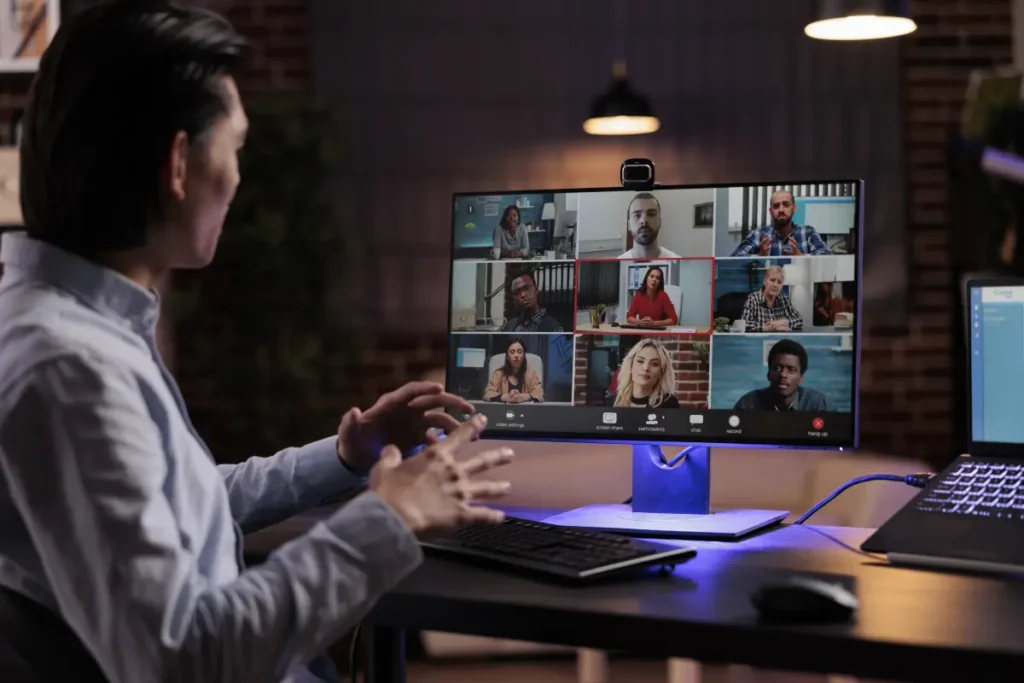Content:
- 1 How remote work has transformed cybersecurity risks
- 2 Why cybersecurity matters in a remote work model
- 3 The most common cyber threats targeting remote teams
- 4 Essential practices to secure a remote workforce
- 5 Tools that help secure remote teams
- 6 The long-term value of building a secure remote culture
- 7 Secure teams build reliable businesses
Working remotely has become part of everyday life for businesses across all kinds of industries. As more teams spread out across locations and enjoy flexible setups, one thing has become especially important: keeping everything secure through strong cybersecurity.
With flexible work setups becoming common across industries, protecting data, systems, and team members has taken on greater importance. Developers, sales professionals, virtual assistants, every role depends on a secure remote environment to keep things running smoothly and to maintain the trust of clients and partners.
This article looks at why cybersecurity plays such a key role in remote operations, what makes it so important for growing teams, and how companies are actively creating safer ways to work. Keep reading to discover how businesses are building secure foundations for their remote teams.
How remote work has transformed cybersecurity risks
When employees worked primarily in centralized offices, IT teams could implement tight security measures across all devices, networks, and software.
Firewalls protected company servers. Physical access to equipment was limited. Updates and patches could be managed internally and uniformly. But remote work flipped that model entirely.
Employees now work from homes, cafés, coworking spaces, airports, and just about anywhere with a stable internet connection. Personal devices are used for business activities, and home Wi-Fi networks often lack enterprise-grade protection.
This geographical and technological decentralization creates a wider surface for cyberattacks and data breaches.
More endpoints, more cloud tools, more third-party access, and fewer centralized controls make it harder to enforce consistent security practices. Because of this shift, remote-first businesses often face more risks like phishing attempts, ransomware attacks, unprotected Wi-Fi connections, and even lost or stolen devices.
Why cybersecurity matters in a remote work model
Every business works with sensitive information in one way or another: client details, financial records, internal conversations, or even creative ideas. When teams work remotely, that information moves through more tools and platforms, which means there are more chances for it to end up somewhere it shouldn’t. Here are several reasons why cybersecurity is fundamental in a remote work environment:
Protecting company data across distributed networks
Your remote team likely uses tools like Slack, Zoom, Google Workspace, or Microsoft 365. These platforms are convenient, but if improperly configured, they can become easy targets.
Cybercriminals exploit weak passwords, unencrypted file transfers, and poor access controls to gain entry into corporate systems. A strong cybersecurity framework protects information from being leaked, stolen, or modified, even when accessed from personal devices and home networks.
Preserving client trust and compliance
Clients trust you with their data. If your business handles confidential contracts, payment details, or medical information, you may also be legally required to comply with regulations such as GDPR, HIPAA, or PCI-DSS.
Failure to secure that data could lead to costly penalties and a damaged reputation. Implementing cybersecurity practices that match the sensitivity of your client data not only keeps you compliant but also builds long-term trust.
Preventing financial and operational disruption
A cyberattack can lead to serious financial damage, sometimes thousands, sometimes much more. In some cases, ransomware has brought entire operations to a halt until systems are recovered or payments are made.
For remote teams without a central office or physical backups, the impact can be even greater. Strong cybersecurity helps by catching threats early, stopping unusual activity, and getting everything back on track quickly when something goes wrong.

The most common cyber threats targeting remote teams
To appreciate the importance of proactive security, it’s important to understand the actual threats remote businesses face. These are not hypothetical scenarios, they happen daily, and often to companies that thought they were “too small” to be targeted.
Phishing attacks are more sophisticated than ever
Phishing emails have become much harder to recognize. Cybercriminals now rely on convincing email addresses, realistic login pages, and carefully written messages to get remote workers to share passwords or open harmful attachments. Just one click on something that looks like an invoice or internal message can give someone access to everything.
Weak password hygiene still exposes companies
Many people reuse passwords or create simple ones that are easy to remember. In a remote setting, without enforced password policies or two-factor authentication, this becomes a serious vulnerability.
Credential stuffing, where attackers use stolen credentials to access multiple platforms, is a common tactic that thrives on weak password practices.
Unsecure devices and networks
Remote workers may use personal laptops or mobile phones to access company resources. These devices might not have antivirus software, encrypted storage, or updated operating systems.
Add to this the use of public or home Wi-Fi networks, and you have an environment where cybercriminals can easily intercept data or plant malicious code.
Shadow IT and unmonitored tools
Employees often download and use tools that haven’t been vetted by IT. This “shadow IT” practice means data could be stored in unsecured third-party apps, shared through unapproved channels, or exposed to vendors with weak security standards. Without proper oversight, businesses lose control over how their data is handled.
Essential practices to secure a remote workforce
Businesses that operate with remote teams thrive when they build a culture that prioritizes security in every part of their workflow.
It means choosing the right tools, setting clear practices, and helping everyone on the team stay aware and prepared to keep information protected at all times. Here are practical, proven strategies that businesses are using to secure their distributed teams:
Establish a remote work security policy
Start with a written policy that outlines security protocols for remote employees. This should include rules for password creation, device usage, software installations, and incident reporting. Everyone should understand their responsibilities when handling company data and using digital tools.
Use endpoint protection and device management
Install security software on all devices used to access company information. This includes antivirus programs, firewalls, and endpoint detection and response (EDR) solutions. Consider using a Mobile Device Management (MDM) system to remotely control device access and wipe data if needed.
Enforce two-factor authentication (2FA)
2FA adds a critical layer of security by requiring users to verify their identity with a second factor, such as a code sent to their phone. This makes it exponentially harder for attackers to breach systems, even if they obtain a user’s password.
Encrypt all data, at rest and in transit
Data encryption protects information from being read or tampered with, even if it is intercepted. Remote businesses should ensure that all cloud services use encryption protocols, and that sensitive files stored on devices are encrypted as well.
Educate employees regularly
Even the best security tools are useless if employees are unaware of risks. Provide ongoing training to help your team recognize phishing attempts, use strong passwords, and report suspicious activity. Awareness is one of the most effective defenses.
Use a VPN for Remote Access
A Virtual Private Network (VPN) encrypts the connection between the user and company servers. This is especially important when employees work from public places or travel internationally. A VPN helps ensure that sensitive communications remain private and protected.
Monitor access and log activity
Keep track of who is accessing your systems, when, and from where. Set up alerts for unusual activity, such as login attempts from unfamiliar locations or at odd hours. Regular audits can help detect compromised accounts early.
Tools that help secure remote teams
Cybersecurity has come a long way for businesses with remote teams. Today, there are tools made specifically to help protect distributed teams while allowing everyone to keep working smoothly, without slowing things down. These include:
- Single sign-on (SSO): Tools like Okta and OneLogin simplify login processes and reduce the number of passwords employees need to remember.
- Password managers: Applications like LastPass or 1Password allow employees to store complex passwords securely without writing them down or reusing them.
- Cloud access security brokers (CASBs): These platforms monitor traffic between users and cloud services, helping enforce security policies and detect shadow IT.
- Secure collaboration platforms: Solutions like Microsoft Teams, Google Workspace Enterprise, or Slack Enterprise Grid offer more advanced security features compared to free versions, including data loss prevention (DLP) and user access controls.

The long-term value of building a secure remote culture
Building strong cybersecurity across remote operations is an ongoing effort that grows with the team. It becomes part of everyday routines, from how people work and collaborate to how new tools are chosen and new team members are onboarded. When security is part of the company’s culture, remote teams stay prepared and flexible as they move through a constantly evolving digital world.
Building trust across time zones
Remote teams often include people from different regions and countries. By prioritizing cybersecurity, businesses show that they take every team member’s safety and privacy seriously. This builds confidence and fosters collaboration, even when people work thousands of miles apart.
Attracting security-conscious clients
Clients today are more aware of digital risks and will ask about your security posture before signing contracts. Companies that can demonstrate strong security protocols have a competitive edge. They signal professionalism, maturity, and a long-term vision, qualities that clients look for in strategic partners.
Scaling safely
As your team grows, so does your attack surface. A strong security foundation allows you to scale without exposing yourself to greater risks. Whether you onboard one new assistant or open an international hub, you already have systems in place to protect your operations.
Secure teams build reliable businesses
Choosing a remote work model opens the door to exciting opportunities, like connecting with talent across different regions and reducing the need for office space. Alongside these benefits, there’s also a need to stay mindful of how the business stays protected. Cybersecurity supports smooth operations, builds client trust, and creates a strong foundation for long-term growth.
When a company focuses on creating a secure remote setup, it builds a strong base for steady growth, smooth operations, and lasting trust. The remote teams that truly thrive are the ones that make security part of their everyday work.
That approach protects valuable information, supports the people behind the work, and strengthens the partnerships that help the business grow with confidence.
At GlobalTeam, we understand how important it is to keep your remote operations secure, efficient, and ready to grow. Our tailored solutions help you build a reliable team while keeping your data and processes protected every step of the way. If you’re ready to scale with confidence and create a safe environment for your remote workforce, let’s talk about how we can support your goals.

